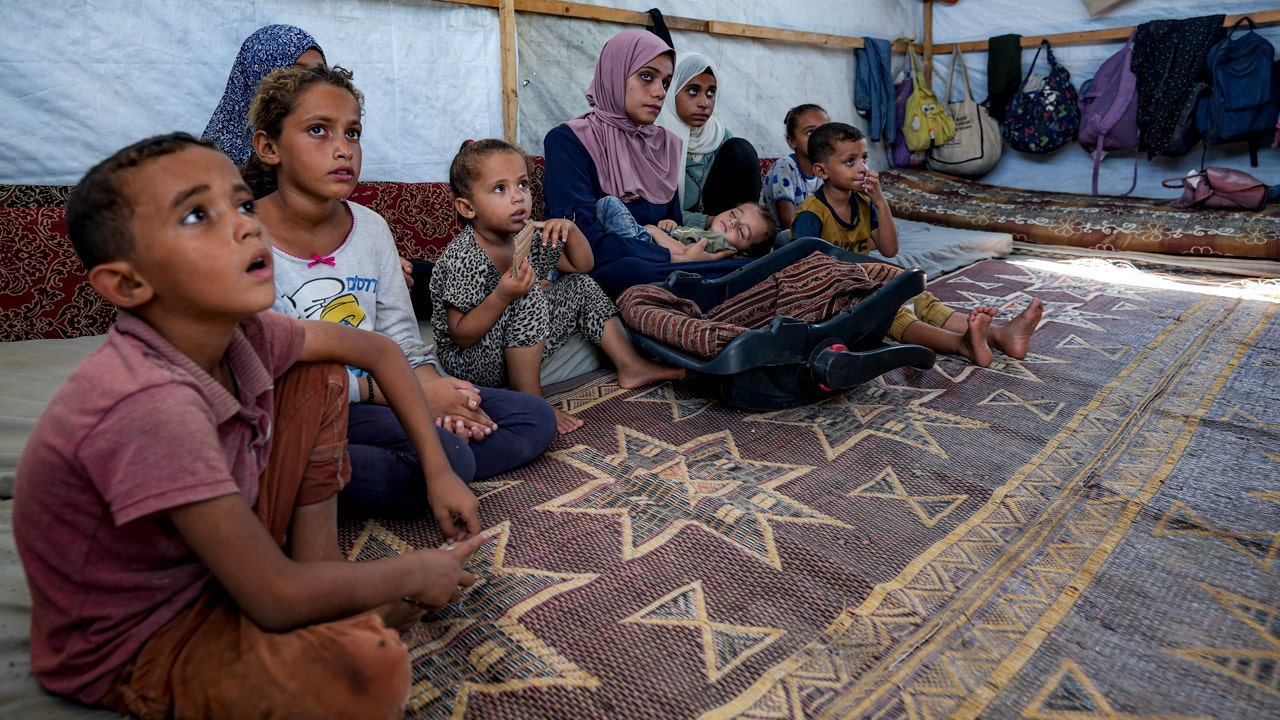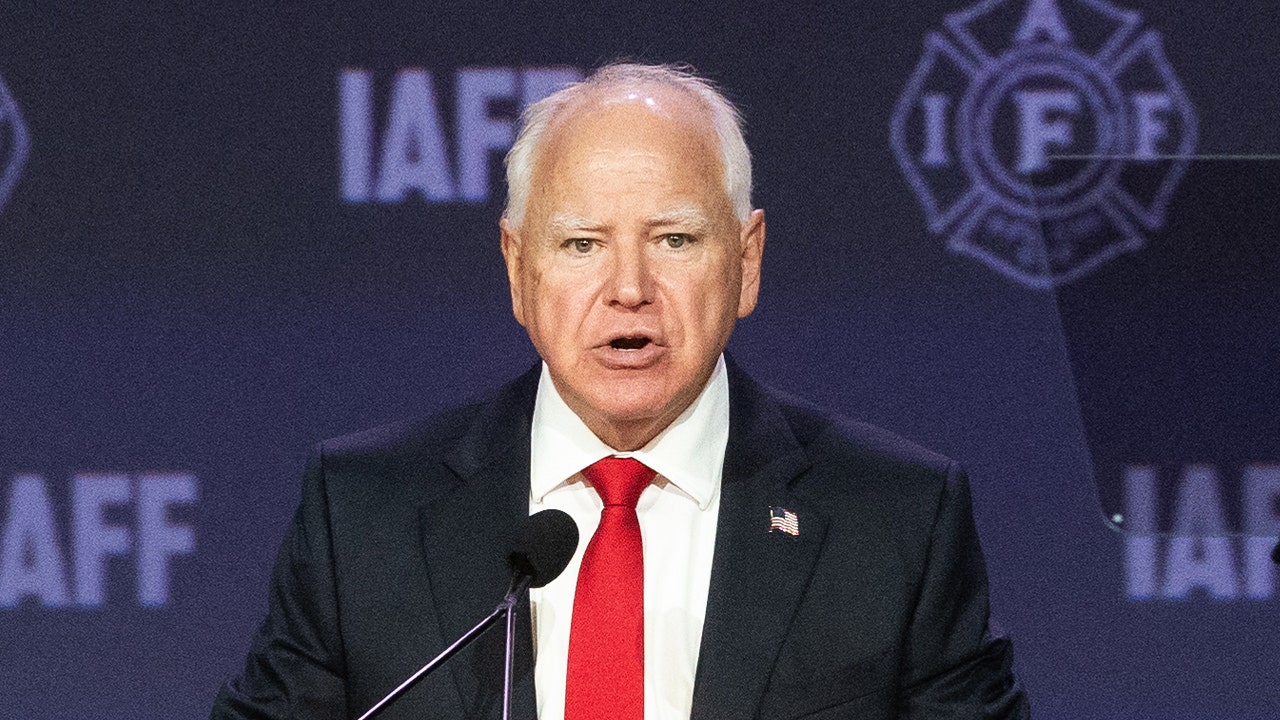World
WHO to deliver 1.3M polio vaccine doses to 640K children in Gaza

- The U.N.’s World Health Organization (WHO) on Sunday is launching a campaign to vaccinate 640,000 Palestinian children against polio after the first case of the disease in Gaza in 25 years was reported.
- Much of Gaza’s healthcare system and roads have been destroyed in the Israel-Hamas war. Gaza’s population is spread throughout the enclave in isolated pockets, posing a challenge to the vaccination effort.
- The WHO said it reached an agreement with Israel to implement pauses in fighting to allow the vaccine campaign to take place.
The U.N. health agency and partners are launching a campaign starting Sunday to vaccinate 640,000 Palestinian children in Gaza against polio, an ambitious effort amid a devastating war that has destroyed the territory’s healthcare system.
The campaign comes after the first polio case was reported in Gaza in 25 years — a 10-month-old boy, now paralyzed in the leg. The World Health Organization says the presence of a paralysis case indicates there could be hundreds more who have been infected but aren’t showing symptoms.
Most people who have polio do not experience symptoms, and those who do usually recover in a week or so. But there is no cure, and when polio causes paralysis it is usually permanent. If the paralysis affects breathing muscles, the disease can be fatal.
DEFENSE MINISTER SAYS ISRAEL MUST ‘WIDEN THE GOALS’ OF WAR TO RETURN RESIDENTS TO THE NORTH
The vaccination effort will not be easy: Gaza’s roads are largely destroyed, its hospitals badly damaged and its population spread into isolated pockets.
WHO said Thursday that it has reached an agreement with Israel for limited pauses in the fighting to allow for the vaccination campaign to take place. Even so, such a large-scale campaign will pose major difficulties in a territory blanketed in rubble, where 90% of Palestinians are displaced.
How long will it take?
The three-day vaccination campaign in central Gaza will begin Sunday, during a “humanitarian pause” lasting from 6 a.m. until 3 p.m., and another day can be added if needed, said Dr. Rik Peeperkorn, WHO’s representative in the Palestinian territories.
Displaced infant Abdel-Rahman Abu El-Jedian, who suffers from polio, is carried by his mother, center, at a makeshift tent camp in Deir al-Balah, central Gaza Strip, on Aug. 27, 2024. (AP Photo/Abdel Kareem Hana)
In coordination with Israeli authorities, the effort will then move to southern Gaza and northern Gaza during similar pauses, he said during a news conference by video from Deir al-Balah in central Gaza.
Who will receive the vaccine?
The vaccination campaign targets 640,000 children under 10, according to WHO. Each child will receive two drops of oral polio vaccine in two rounds, the second to be administered four weeks after the first.
Where are the vaccination sites?
The vaccination sites span Gaza, both inside and outside Israeli evacuation zones, from Rafah in the south to the northern reaches of the territory.
The Ramallah-based Health Ministry said Friday that there would be over 400 “fixed” vaccination sites — the most in Khan Younis, where the population density is the highest and there are 239,300 children under 10. Fixed sites include healthcare centers, hospitals, clinics and field hospitals.
Elsewhere in the territory, there will also be around 230 “outreach” sites — community gathering points that are not traditional medical centers — where vaccines will be distributed.
Where are the vaccines now?
Around 1.3 million doses of the vaccine traveled through the Kerem Shalom checkpoint and are currently being held in “cold-chain storage” in a warehouse in Deir al-Balah. That means the warehouse is able to maintain the correct temperature so the vaccines do not lose their potency.
Another shipment of 400,000 doses is set to be delivered to Gaza soon.
The vaccines will be trucked to distribution sites by a team of over 2,000 medical volunteers, said Ammar Ammar, a spokesperson for UNICEF.
What challenges lie ahead?
Mounting any sort of campaign that requires traversing the Gaza strip and interacting with its medical system is bound to pose difficulties.
The U.N. estimates that approximately 65% of the total road network in Gaza has been damaged. Nineteen of the strip’s 36 hospitals are out of service.
The north of the territory is cut off from the south, and travel between the two areas has been challenging throughout the war because of Israeli military operations. Aid groups have had to suspend trips due to security concerns, after convoys were targeted by the Israeli military.
Peeperkorn said Friday that WHO cannot do house-to-house vaccinations in Gaza, as they have in other polio campaigns. When asked about the viability of the effort, Peeperkorn said WHO thinks “it is feasible if all the pieces of the puzzle are in place. “
How many doses do children need and what happens if they miss a dose?
The World Health Organization says children typically need about three to four doses of oral polio vaccine — two drops per dose — to be protected against polio. If they don’t receive all of the doses, they are vulnerable to infection.
Doctors have previously found that children who are malnourished or who have other illnesses might need more than 10 doses of the oral polio vaccine to be fully protected.
Are there side effects?
Yes, but they are very rare.
Billions of doses of the oral vaccine have been given to children worldwide and it is safe and effective. But in about 1 in 2.7 million doses, the live virus in the vaccine can paralyze the child who receives the drops.
How did this outbreak in Gaza start?
The polio virus that triggered this latest outbreak is a mutated virus from an oral polio vaccine. The oral polio vaccine contains weakened live virus and in very rare cases, that virus is shed by those who are vaccinated and can evolve into a new form capable of starting new epidemics.

World
Ghosts of Germany’s Past Evoked in Venice Films ‘Riefenstahl,’ ‘September 5’

Andres Veiel’s documentary “Riefenstahl,” which challenges the carefully crafted public persona of one of Germany’s most controversial directors, who was forever tainted by working with the Nazis, is one of 17 German films playing in the various sections of the Venice Film Festival.
A deep dive into Leni Reifenstahl’s previously inaccessible archive, the 160-minute film lifts the lid on secrets the director of the 1935 Nuremberg propaganda film “Triumph of the Will” struggled more than half her life to keep hidden.
Veiel, who was brought onboard to direct by producer Sandra Maischberger of Berlin’s Vincent Films – who had gained unfettered access to Riefenstahl’s archive after the death of her longtime companion and husband Horst Kette in 2016 – is untroubled by the film’s out-of-competition berth as he believes the festival is the right venue for its first showing.
“For me, it is the right festival for the film,” Veiel tells Variety. “The political situation in German and Italy is similar – with the rise of the right-wing, and a longing for propaganda and fake news. For a debate about the film, it is one of the best festivals for us.”
There are also ghosts of the past in Venice – Riefenstahl screened several of her films at the festival in the 1930s, including her two Nazi propaganda films, and her first feature “The Blue Light,” made in 1932. She even had a retrospective on the Lido in the 1950s, at a time when she was just beginning to construct a persona distanced from the Nazis, and – as “Riefenstahl” shows – largely built on lies.
Although not an easy film to watch – as Veiel succeeds in proving her apparent complicity in the murder of Jewish men in Poland and admiration for Hitler – “Riefenstahl” is likely to prove a hot ticket in Venice.
Another much-anticipated film, Tim Fehlbaum’s Munich summer 1972 Olympics feature “September 5,” is playing in the Horizons Extra competition section. Starring Peter Sarsgaard and John Magaro, and revolving around the sports reporting team of U.S. broadcaster ABC, who have to switch from covering track and field events to the Israeli athletes’ hostage crisis, it focuses on how tragic events can also challenge the moral compass of journalists covering them.
In Horizons, Scandar Copti’s “Happy Holidays” tells the story of a Palestinian woman whose double life is revealed after a car accident in Jerusalem, and “Quiet Life,” directed by Alexandros Avranas, focuses on a family of asylum seekers whose hopes of creating a new life in Sweden are dashed when their application is rejected.
Two German co-productions are screening in the main competition – Athina Rachel Tsangari’s “Harvest,” adapted from the prize-winning book of the same name about an unnamed English village that seems to exist in neither time nor place – before it disappears for ever. There is also the Italian-German-U.S. co-production, “Maria” by Pablo Larrain, which tells the story of opera singer Maria Callas.
Looking further ahead, German films are also heading to the Toronto Film Festival.
Key films in the lineup there include Fabian Stumm’s sophomore film “Sad Jokes” playing as an international premiere in the festival’s Discovery section. It focuses on the relationship between Joseph and Sonya – who are raising a son together although their relationship is platonic. Things go awry when Sonya has a breakdown, tearing Joseph’s attention away from a new film project – and the pain of a break-up with his ex-boyfriend, Marc.
Others already announced include “Edge of Night” by Türker Süer; “Seven Days” by Amil Samadi Ahadi, and “The Sunset Special 2” by Nicolas Gebbe.
World
Oasis fans struggle to secure tickets for band’s reunion tour

Oasis fans seeking tickets to the band’s reunion tour have had to endure hour long waits, and in some cases disappointment, as online platforms have been strained under demand from hundreds of thousands of fans.
The Britpop-era behemoth led by brothers Noel and Liam Gallagher is scheduled to play 17 gigs — its first shows for 15 years — in Cardiff, Manchester, London, Edinburgh and Dublin starting July 4 next year.
More than one million tickets went on sale Saturday morning, with prices starting at about 74 pounds (just under $100).
But some people attempting to get onto the handful of authorised sales sites, including Ticketmaster and Gigs and Tours, received error messages, while many others were informed they were in a lengthy queue.
Josh Jeffery, a videographer who lives near Edinburgh, spent hours moving up the online ticket queue, before “the whole site collapsed” at the last step.
“I’ve given up, my friends have given up,” Jeffery, who first saw Oasis in Manchester as a teenager in 1996, told The Associated Press news agency. “We just decided it’s too much hassle.
“As I was in the queue, I heard Wonderwall blasting out from my neighbour’s house,” he added ruefully. “He’d obviously got tickets.”
Some fans managed to buy tickets through a presale lottery on Friday.
Barista Isabelle Doyle told the AP she was “over the moon” after snagging two seats for one of the band’s London shows.
“I’ve been a fan of Oasis for about 10 years now, literally since I was 11 years old,” the 21-year-old said. “Finally to be able to see them after they got me through as a teenager, it’s absolutely amazing and I’m so excited.”
Within hours, tickets began to be offered on resale websites for as much as 6,000 pounds ($7,800).
Oasis issued a warning, saying tickets could only be resold at face value through authorised sites.
“Tickets appearing on other secondary ticketing sites are either counterfeit or will be cancelled by the promoters,” it said in a statement.
Fans are not just trying to get into the shows.
Cheap hotel rooms also appear to have been replaced by pricier options on travel sites in the reunion tour host cities like Manchester.
Some people reported on social media that hotels had sought to cancel bookings they had made prior to the tour dates being announced, in a bid to relist them at a higher price.
The gigs are expected to provide a multimillion-pound boost for Britain’s hospitality sector and economy.
“There will be huge sums of money spent on merchandise, travel, hotels, bars and restaurants, as well as creating jobs which are all linked directly to these gigs,” Paul Haywood-Schiefer, senior manager at tax advisory firm Blick Rothenberg, told the Reuters news agency.
Although Oasis, one of the biggest British bands of recent decades, said plans were under way to go to other continents, fans were likely to fly in from abroad for the British shows.
“If you want to see Oasis, really the best place to do it is here in the UK where they mean so much,” Sutherland said.
Formed in Manchester in 1991, Oasis was one of the dominant British acts of the 1990s, producing hits including Wonderwall and Don’t Look Back in Anger. Its sound was fuelled by singalong rock choruses and the combustible chemistry between guitarist-songwriter Noel Gallagher and singer sibling Liam.
Oasis split in 2009, with Noel Gallagher quitting the band after a backstage dustup with his brother at a festival near Paris. While the Gallagher brothers, now aged 57 and 51, have not performed together since, both regularly perform Oasis songs at their solo gigs. They have also each fired off criticisms of the other in the press.
Announcing the reunion, the band said fans would experience “the spark and intensity” that occurs only when they appear on stage together.
World
Catholics face a shortage of priests. But one Indonesian seminary is overwhelmed with applicants
MAUMERE, Indonesia (AP) — Arnoldus Yansen thought for certain he was going to become a Catholic priest, just like his older brother, cousin and uncle.
He attended St. Peter Major Seminary, a bastion of priestly vocations located in the middle of a jungle on Flores, a predominantly Catholic island in Muslim-majority Indonesia. Known familiarly as Ritapiret Seminary, St. Peter Major has produced 13 bishops, more than 580 diocesan priests and 23 deacons in nearly 70 years of existence.
But Yansen won’t be among them. He tried to shake off what he thought were last-minute jitters before entering the priesthood. Instead, Yansen took off his clerical robes for good and joined the hundreds of prospective priests who resign or fail to take up Catholic vocations every year in Indonesia.
“I felt like I didn’t fit in anymore and that I would be able to do more if I left,” said Yansen, 26, who is now an administrator at a Catholic school, Ledalero Institute of Philosophy and Creative Technology.
Pope Francis’ upcoming trip to Indonesia is putting a spotlight on the 8.6 million Catholics who make up 3% of the population. It’s a country where religious minorities remain on edge due to militant attacks that have targeted faith groups.
More men are entering seminary, but Yansen and others like him show that Indonesia is not immune from trends contributing to the Catholic Church’s global priest shortage, including fallout from the clergy sex abuse crisis and the pull of the fast-paced modern world.
“The number of priests is never enough,” said the Rev. Guidelbertus Tanga, rector of St. Peter Major Seminary, which is considered the largest Catholic seminary in the world by enrollment.
Catholic priests leave after the ordination ceremony of the Paulus Budi Kleden as the new bishop of Ende, at the Christ the King Cathedral church in Ende, East NusaTenggara province, Indonesia, Thursday, Aug. 22, 2024. (AP Photo/Tatan Syuflana)
In Indonesia, there 2,466 diocesan priests in Indonesia in 2022, up from 2,203 in 2017, according to Vatican statistics as of Dec. 31, 2022, the last year for which data is available. That number is supplemented by even more religious order priests, such as Jesuits or Franciscans, whose numbers reached 3,437 in 2022.
But Tanga noted that Indonesia’s population growth is outpacing priesthood vocations. “We will continue to face a shortage of priests in the future if nothing is done now.”
Asia, along with Africa, has long been seen as the future of the Catholic Church, both in terms of the number of baptized faithful and the number of men and women who decide to become priests or nuns.
The Philippines and India outpace Indonesia. But compared to all of Asia, the number of seminarians in Indonesia is growing while it levels off or declines across the continent.
While the Catholic Church is faced with priest-less parishes in many parts of the world, Ritapiret Seminary is overwhelmed with applicants.
Seminarians of Ritapiret Major Seminary climb onto a the truck that will take them to their classes at Ledalero Institute of Philosophy and Creative Technology in Maumere, East NusaTenggara province, Indonesia, Friday, Aug. 23, 2024. (AP Photo/Tatan Syuflana)
Seminarians climb onto a the truck that will take them to their classes at Ritapiret Major Seminary in Maumere, East NusaTenggara province, Indonesia, Friday, Aug. 23, 2024. (AP Photo/Tatan Syuflana)
Men training to be diocesan priests typically spend six to eight years in the seminary, and two years of pastoral work, before ordination. Less than 20 seminarians can be ordained each year, Tanga said.
“To answer God’s calling and to choose a life as (a) priest remain something fascinating for people in this region,” Tanga said. “And yet we still appeal (to) youths to have courage to make a decision to take up church vocation, and the support from their families and society.”
He knows monastic life isn’t for everyone. Some consider taking up a vocation to be too dull when compared to more modern ways of life.
Tanga said seminaries are now being challenged to brand and promote themselves to encourage young people to become priests. The school with 62 lecturers — more than half of whom are priests — is now a college where the public can study digital technology, economics, and how to become Catholic religion teachers.
During Pope John Paul II’s visit to Indonesia in 1989, he hailed the faithfulness of people in Flores and the flourishing number of priests and nuns. He praised the seminarians in Ritapiret, saying: “You must also understand that faithful service to Christ and his Church will not always earn you the world’s praise. On the contrary, you will sometimes receive the same treatment as the Lord: rejection, contempt, and even persecution.”
Now a saint, the room he spent the night in at the seminary has become a spiritual tourism destination.
Portraits of Pope John Paul II are displayed in a room where he stayed during his visit in 1989, at Ritapiret Major Seminary in Maumere, East NusaTenggara province, Indonesia, Friday, Aug. 23, 2024. (AP Photo/Tatan Syuflana)
Inosentius Mansur, who is on the seminary staff, said their data shows that the Catholic priest shortage is not caused by a loss of resources, but by a “loss of moral commitment.”
Sex abuse scandals and other unflattering news reports emerging from the Vatican and elsewhere contributed to Yansen’s decision to leave the path to priesthood, he said.
Beyond the internal challenges, violent attacks are also a concern of the church in Indonesia. Although the country promotes itself as a bastion of tolerance in the Muslim world, a small extremist fringe has become more vocal in recent years.
In 2021, a militant couple blew themselves up outside a packed Catholic cathedral on Indonesia’s Sulawesi island during a Palm Sunday Mass, wounding at least 20 people.
Bishop Siprianus Hormat of Ruteng said he still believes that most Indonesians are tolerant unless something triggers a conflict, and that the country has a pluralist society that respects freedom of religion.
“In general, acts or behaviors of intolerance are still there, but on a small scale,” Hormat said. “This is actually not a problem that is purely related to religious issue, but it was used to fuel people’s anger to oppress their political rivals or those who don’t agree with them.”
Though religious freedom is protected by Indonesia’s constitution, members of religious minorities and atheists have been increasingly subjected to discrimination.
“Diversity of Indonesia is a reality that we cannot deny,” Hormat said. “We cannot tolerate any actions that aim to eliminate certain religion or race from this country.”
Parishioners leave after a Sunday mass at St. Joseph Cathedral Church in Maumere, East Nusa Tenggara province, Indonesia, Sunday, Aug. 25, 2024. (AP Photo/Tatan Syuflana)
The United States Commission on International Religious Freedom said in its annual report in January that blasphemy allegations and convictions remain persistent religious freedom violations throughout Indonesia.
The report said a new criminal code that will be implemented in 2026 will further criminalize blasphemy and expand on other violations. There also are concerns about local government initiatives to codify discrimination against minority communities gaining traction. In some schools, there are religious clothing mandates, including wearing a hijab, even for non-Muslim girls.
“We believe in what Jesus said, that even though this world ends, my kingdom there will be no end,” said Tanga, the seminary’s rector, adding that the Catholic Church, though it has been through crises before, “will never become extinct.”
“It means the vocations to become a priest and dedication to the service of Christ and his church will never wane,” he said.
Seminarians attend morning Mass at Ritapiret Major Seminary in Maumere, East NusaTenggara province, Indonesia, Friday, Aug. 23, 2024. (AP Photo/Tatan Syuflana)
___
Associated Press writer Nicole Winfield in Rome contributed to this report.
___
Associated Press religion coverage receives support through the AP’s collaboration with The Conversation US, with funding from Lilly Endowment Inc. The AP is solely responsible for this content.
-

 Connecticut1 week ago
Connecticut1 week agoOxford church provides sanctuary during Sunday's damaging storm
-

 Technology1 week ago
Technology1 week agoBreakthrough robo-glove gives you superhuman grip
-

 Politics1 week ago
Politics1 week agoClinton lauds Biden as modern-day George Washington and president who 'healed our sick' in DNC speech
-

 Politics1 week ago
Politics1 week agoTrump taunted over speculated RFK Jr endorsement: 'Weird as hell'
-

 Politics1 week ago
Politics1 week ago2024 showdown: What happens next in the Kamala Harris-Donald Trump face-off
-

 Politics1 week ago
Politics1 week agoVivek Ramaswamy sounds off on potential RFK Jr. role in a Trump administration
-

 News1 week ago
News1 week agoWho Are Kamala Harris’s 1.5 Million New Donors?
-

 World5 days ago
World5 days agoPortugal coast hit by 5.3 magnitude earthquake













